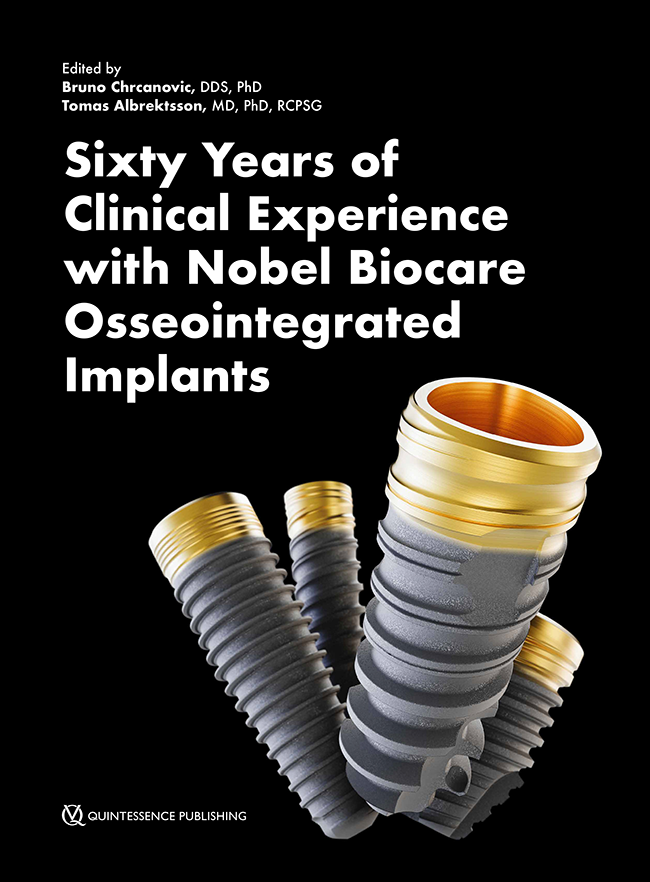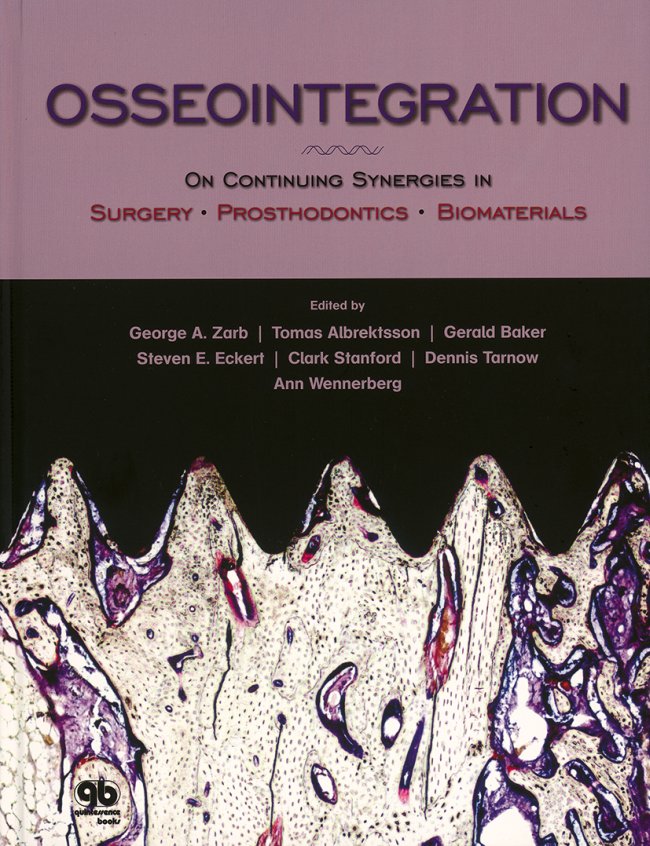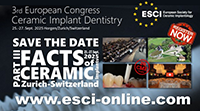The International Journal of Oral & Maxillofacial Implants, 2/2025
DOI: 10.11607/jomi.11002, PubMed-ID: 38941171Seiten: 257-261, Sprache: EnglischWadhwani, Chandur P.K. / Albrektsson, Tomas / Schoenbaum, Todd R. / Chung, Kwok-HungPurpose: To investigate residual debris within internal features of new “as received” dental implants. Materials and Methods: A total of 15 new dental implants representing various dental implant brands were obtained in sealed containers from the manufacturers. Batch numbers and implant types were documented. In a controlled setting, implants were carefully unpacked, and their internal aspects were visually examined. Further analysis involved light microscopy imaging to document and photograph any foreign material. The internal aspect of the implants were sampled with both an endodontic paper cone and a fine bristle brush swab. These were inserted into the implant, rotated three times, then removed and examined under a microscope at 30× magnification. After sampling, some of the brushes and swabs were washed with alcohol to remove debris that could be further examined under magnification. Results: Inspection of the implants without magnification revealed no visible foreign materials. However, under light microscopy (10× and 30×), all 15 implants exhibited small black particles at various internal sites, including connections, threads, and deep within screw channels. Swabs evaluated at magnification detected what appeared to be metal particles in all 15 implants, ranging from distinct metal shards to smaller particles. Conclusions: This study suggests that implant manufacturers have not effectively removed all machining debris from within implant bodies, potentially producing prosthetic and clinical complications.
Schlagwörter: biomaterials, biomechanics, machining debris, microsurface, surface
The International Journal of Oral & Maxillofacial Implants, 6/2024
DOI: 10.11607/jomi.10820, PubMed-ID: 38498790Seiten: 922-930, Sprache: EnglischAmengual, Luis / Brañes, Manuel / Marchesani, Francisco / Parada, Leopodo / Jara, Maria Constanza / Albrektsson, TomasPurpose: To evaluate the feasibility of reversing a primary failure through therapeutic mechanical stimulation induced by transcutaneous application of acoustic waves (extracorporeal shockwave therapy [ESWT]) in the peri-implant tissues. Materials and Methods: This clinical report evaluates the outcome of a new protocol proposed to treat a primary failure (loosened oral implant): application of three cycles of ESWT (one session per week for 3 consecutive weeks) with an equivalent positive energy of 0.18 mJ/mm2 (therapeutic dose: 2,000 pulses, 8 Hz, 4.0 bar). Standardized intraoral radiographs and CBCT scans were taken, the implant stability quotient (ISQ) was determined, and clinical evaluations were performed. Results: It was possible to verify a progressive increase in ISQ values after the ESWT protocol: 17 initially, 46 at 2 months, and 68 at 4 months. This led to successful implant prosthetic rehabilitation (35 Ncm). Follow-up evaluations at 6 years confirm that the new bone-implant interface is preserved and that ESWT is a safe, noninvasive treatment. Conclusions: In the context of the new dynamic model of osseointegration (the foreign body equilibrium), this represents the first report of a host-implant equilibrium reestablished after an early implant failure process. However, more studies are needed to determine both the medical device and the most effective therapeutic range for clinical applications of this technology in oral implantology.
Schlagwörter: case report, ESWT, oral implant, osseointegration, osteoimmunology, primary failure
The International Journal of Oral & Maxillofacial Implants, 5/2024
DOI: 10.11607/jomi.10780, PubMed-ID: 38394441Seiten: 755-764, Sprache: EnglischReinedahl, David / Galli, Silvia / Albrektsson, Tomas / Tengvall, Pentti / Wennerberg, AnnPurpose: Marginal bone resorption (MBR) around dental implants may sometimes be a self-limiting condition due to balancing immunologic reactions against utilized materials rather than a progressive bacterial infection. Contrary to previous assumptions from ligature-induced experimental peri-implantitis studies, a recent 8-week experiment by the present authors showed that marginal ligatures trigger an inflammatory immune response, resulting in bone resorption around implants in the absence of plaque. The present study aimed to investigate whether this inflammatory/immunologic reaction attenuates or progresses toward implant failure after a longer healing time (12 weeks). Materials and Methods: Sterile silk ligatures were placed around the top of titanium (Ti) implants and compressed against the femoral cortical bone plate of six rabbits. A nonligated implant was used as a control. After 12 weeks of submerged healing, ground sections of implants and surrounding tissues were investigated with light microscopy. The marginal soft tissues were also analyzed using selected quantitative polymerase chain reaction (qPCR) markers. Results: Histologically, the ligatures were outlined by immune cells, including multinucleated giant cells (MNGCs), with adjacent fibrous encapsulation and resorbed peripheral bone that contrasted from the osseointegrated nonligated control implants. The difference in expression of qPCR markers was not significant, but > two-fold upregulation of markers CD11b, IL1β, ARG1, NCF1, and CD4 and > twofold downregulation of CD8 indicated a mild, focal inflammatory/immune response against the ligatures compared to controls, with upregulation of M1 and M2 macrophages, neutrophils, and helper T-cells as well as downregulation of killer T cells. Further, the bone formation markers OC and ALPL were > two-fold downregulated (consistent with the lack of osseointegration of the ligatures) compared to control implants. Conclusions: Marginal silk ligatures trigger an inflammatory/immune response and aseptic bone resorption around implants. Compared to the previous 8-week study, the inflammatory reaction against the silk appears to attenuate with time, with only a mild persisting inflammation that may block osseointegration; instead, a fibrous tissue encapsulation–type reaction is maintained. This may explain why traditional ligature experiments have required regular exchange of ligatures for the bone resorption to progress.
Schlagwörter: bone loss, dental implant, immunology, ligature, osseointegration
The International Journal of Oral & Maxillofacial Implants, 3/2024
DOI: 10.11607/jomi.10654, PubMed-ID: 38607359Seiten: 389-395, Sprache: EnglischÖstman, Pär-Olov / Chrcanovic, Bruno Ramos / Albrektsson, TomasPurpose: To present a survival analysis of 133 consecutively placed moderately rough implants, all with a total follow-up of 20 years. Materials and Methods: A total of 133 implants of the same brand placed in 46 patients at the same county clinic in Sweden were followed up prospectively over 20 years and analyzed for survival and bone height, the latter evaluated in periapical radiographs. Results: A total of 7 implants failed, 4 of which were in the same patient. Implant failure was associated with a combination of smoking and bruxism in 5 of the 7 failed cases. A 20-year survival rate of 94.7% was observed. Average marginal bone loss (MBL) at 20 years of follow-up was 0.543 ± 1.193 mm, with 9 implants having more than 2 mm of MBL. A total of 20 patients with 25 implants dropped out of the study; however, if death of the patient is excluded as a dropout reason, only 3 implants in 3 patients were unaccounted for. Conclusions: Good clinical results in the 95% survival range were observed with moderately rough implants over a 20-year follow-up period.
The International Journal of Oral & Maxillofacial Implants, 5/2023
DOI: 10.11607/jomi.10694, PubMed-ID: 37847825Seiten: 838-840, Sprache: EnglischJensen, Ole T. / Albrektsson, Tomas / Jemt, TorstenThe International Journal of Oral & Maxillofacial Implants, 5/2021
DOI: 10.11607/jomi.8837Seiten: 863-874, Sprache: EnglischDuddeck, Dirk U / Albrektsson, Tomas / Wennerberg, Ann / Larsson, Christel / Mouhyi, Jaafar / Beuer, Florian
Purpose: After some initial setbacks in the 1970s, ceramic implants seem to be a promising alternative to titanium implants. Since the surface of an implant system represents the interface to surrounding biologic structures, the study focuses on cleanliness and surface topography. Clinical documentation of the corresponding systems completes the picture and allows a better evaluation of zirconia implant systems.
Materials and methods: Five different ceramic implant systems were selected randomly and purchased via blind-shopping: Z5s (Z-Systems), ZiBone (COHO), W implant (TAVDental), ceramic. implant (vitaclinical), and BioWin!/Standard Zirkon Implantat (Champions-Implants/ZV3 system). Three samples of each implant system underwent scanning electron microscopy (SEM) imaging and elemental analysis (EDS). Where appropriate, subsequent Time-of-Flight Secondary Ion Mass Spectrometry (ToF-SIMS) was performed to identify the chemical nature of impurities. Surface topography was evaluated, and a search for clinical trials in the PubMed database, on the websites and by written request to each dental implant manufacturer, was performed.
Results: Surfaces of Champions implants (ZV3) and Z-Systems implants were relatively clean, whereas the other investigated surfaces of vitaclinical, TAV Dental, and ZiBone implants all displayed organic contaminations on their surfaces. Four of the investigated ceramic implants showed a moderately rough implant surface. Only the vitaclinical ceramic.implant had minimal surface roughness. Three ceramic designs-vitaclinical, ZV3, and Z-Systems-had clinical trials documented with up to 3 years of follow-up and results varying between 82.5% and 100% survival. TAV Dental W and ZiBone implant systems lacked properly conducted clinical recording of results.
Conclusion: The results of this study showed that it is technically possible to produce zirconia implants that are largely residue-free. On the other hand, the variety of significant residues found in this analysis raises concerns, as contamination may lead to undesirable biologic effects. The lack of clinical studies in peer-reviewed journals does not seem to be relevant for the approval of marketing, nor does the lack of surface cleanliness. In the authors' opinion, a critical analysis of these aspects should be included in a more stringent future analysis prior to the marketing of oral implant systems.
Schlagwörter: ceramic implants, dental implants, implant contamination, implant surface, scanning electron microscopy, surface, surface properties, zirconia
The International Journal of Prosthodontics, 5/2020
DOI: 10.11607/ijp.6701, PubMed-ID: 32956432Seiten: 513-522, Sprache: EnglischGjelvold, Björn / Kisch, Jenö / Mohammed, Deyar Jallal Hadi / Chrcanovic, Bruno Ramos / Albrektsson, Tomas / Wennerberg, AnnPurpose: To compare clinical and esthetic outcomes between immediately loaded single implants placed with and without a fully guided surgical procedure.
Materials and Methods: Patients with a missing maxillary tooth (second premolar to second premolar) were considered for inclusion in this 1-year prospective nonrandomized study. Exclusion criteria were general health contraindications for oral surgery besides the need for bone grafting or ridge augmentation. One group received digital implant planning, fully guided surgery, and immediate loading (DIL). The other group received freehand surgery and immediate loading (IL). Outcome measures were implant survival, marginal bone loss, soft tissue changes, papilla index, pink and white esthetic scores (PES and WES, respectively), and patient-reported outcome measures (PROMs).
Results: Two of 21 implants failed in the DIL group soon after placement, resulting in a 1-year implant survival rate of 90.5%, while no implants failed in the IL group. Significantly higher papilla index scores and lower soft tissue changes were found for the DIL group compared to the IL group. No differences were found after 1 year regarding marginal bone loss, PES, WES, or PROMs.
Conclusion: Within the limitations of this study, immediate loading in combination with fully guided surgery might negatively affect implant survival. Immediate loading, fully guided surgery, and a digital workflow appear to have a positive effect on early soft tissue adaptation.
The International Journal of Oral & Maxillofacial Implants, 3/2020
DOI: 10.11607/jomi.8218, PubMed-ID: 32406645Seiten: 495-502, Sprache: EnglischAlbrektsson, Tomas / Dahlin, Christer / Reinedahl, David / Tengvall, Pentti / Trindade, Ricardo / Wennerberg, AnnPurpose: The purpose of this paper is to present evidence that supports the notion that the primary reason behind marginal bone loss and implant failure is immune-based and that bacterial actions in the great majority of problematic cases are of a secondary nature.
Materials and Methods: The paper is written as a narrative review.
Results: Evidence is presented that commercially pure titanium is not biologically inert, but instead activates the innate immune system of the body. For its function, the clinical implant is dependent on an immune/inflammatory defense against bacteria. Biologic models such as ligature studies have incorrectly assumed that the primary response causing marginal bone loss is due to bacterial action. In reality, bacterial actions are secondary to an imbalance of the innate immune system caused by the combination of titanium implants and ligatures, ie, nonself. This immunologic imbalance may lead to marginal bone resorption even in the absence of bacteria.
Conclusion: Marginal bone loss and imminent oral implant failure cannot be properly analyzed without a clear understanding of immunologically caused tissue responses.
Schlagwörter: biomaterials, failure analysis, immunologic reactions, peri-implantitis, review (narrative)
The International Journal of Oral & Maxillofacial Implants, 2/2020
DOI: 10.11607/jomi.7488, PubMed-ID: 32142574Seiten: 366-378, Sprache: EnglischAparicio, Carlos / López-Piriz, Roberto / Albrektsson, TomasZygomatic-related implant rehabilitation differs from traditional implant treatment in biomechanics, clinical procedures, outcomes, and eventual complications such as soft tissue incompetence or recession that may lead to recurrent sinus/soft tissue complications. The extreme maxillary atrophy that indicates the use of zygomatic implants prevents use of conventional criteria to describe implant success/failure. Currently, results and complications of zygomatic implants reported in the literature are inconsistent and lack a standardized systematic review. Moreover, protocols for the rehabilitation of the atrophic maxilla using zygomatic implants have been in continuous evolution. The current zygomatic approach is relatively new, especially if the head of the zygomatic implant is located in an extramaxillary area with interrupted alveolar bone around its perimeter. Specific criteria to describe success/survival of zygomatic implants are necessary, both to write and to read scientific literature related to zygomatic implant–based oral rehabilitations. The aim of this article was to review the criteria of success used for traditional and zygomatic implants and to propose a revisited Zygomatic Success Code describing specific criteria to score the outcome of a rehabilitation anchored on zygomatic implants. The ORIS acronym is used to name four specific criteria to systematically describe the outcome of zygomatic implant rehabilitation: offset measurement as evaluation of prosthetic positioning; rhino-sinus status report based on a comparison of presurgical and postsurgical cone beam computed tomography in addition to a clinical questionnaire; infection permanence as evaluation of soft tissue status; and stability report, accepting as success some mobility until dis-osseointegration signs appear. Based on these criteria, the assessment of five possible conditions when evaluating zygomatic implants is possible.
Schlagwörter: criteria of success, ORIS, review (narrative), ZAGA, zygomatic implants, zygomatic success code
The International Journal of Prosthodontics, 7/2018
SupplementSeiten: 11-14, Sprache: EnglischAlbrektsson, Tomas








